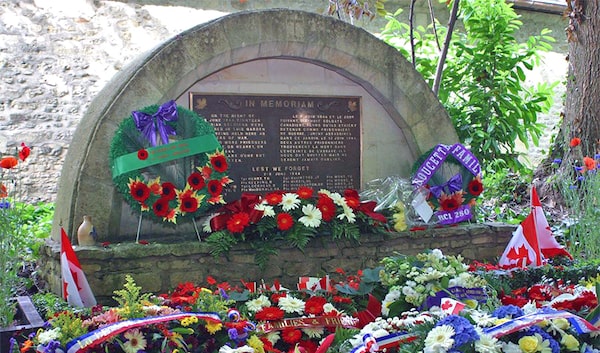
The Abbaye d’Ardenne memorial in Normandy honours 20 Canadian POWs executed by the Germans in June 1944.Veterans Affairs Canada
Heidi Legg is a Canadian-American journalist, the director of special projects at the Shorenstein Center on Media, Politics and Public Policy at the Harvard Kennedy School and founder of TheEditorial.com.
On my dresser, I keep a small circular wooden box with a metal decoupage cover. Through the cut spaces, you will notice a silver coin depicting the Louvre, a Canadian penny that is no longer minted, and another that reads In God We Trust – coins from the countries that have forged me. This box has travelled with me through Montreal, London, San Francisco, Toronto and Cambridge.
Its decoupage pattern resonated when I found it in Normandy in France, filming the CTV documentary The Final Reunion for two weeks in 1994, the 50th anniversary of D-Day. It was a talisman to ensure I would not forget what I learned chronicling three Canadian soldiers, a Canadian nurse and a German couple who had all agreed to retrace their paths.
Each morning, we would all meet for breakfast. The German soldier, well into his 70s, would eat alone with his wife; they didn’t feel comfortable sitting with the Canadians, and vice versa, and I couldn’t blame them. George Blackburn, a Canadian soldier on the front line, was a kind, fragile soul with a poet’s gentleness; I had difficulty picturing him climbing those beaches, but he did. Sid Radley Walters had been a tank commander when he saw his buddy’s tank explode in front of him; he returned to Canada and married his friend’s widow. She held his hand through much of the filming.
Our film crew was in France months before foreign dignitaries and royalty descended to mark the remembrance, and with Normandy to ourselves, we witnessed beautiful moments that weren’t manufactured for the benefit of the world’s eyes. At the Canadian War Cemetery in Bény-sur-Mer, for instance, the veterans softened as schoolchildren sang the Canadian anthem, parading flags for the returning liberators who survived to witness the progress furnished from their deep sacrifice. We watched as Quebecker Michel Gauvin, who refused to accept he was a hero for capturing 250 Germans in the caves in France’s Fontaine-Henry using an argument, not a gun, learn that local children make dioramas every year to commemorate his extraordinary act of reason. An older farmer invited us into his cellar, where he proceeded to open a bottle of Calvados brandy from the 1960s. At 23, it burned my throat, but I recognized its importance.
But nothing prepared me for Ardennes Abbey. It was an observation post, taken by the Germans in the Battle of Normandy. It was also the place where 20 Canadian prisoners were shot to death, one by one, by members of the 12th SS Panzer Division Hitlerjugend over the course of the month of June.
As I mounted the crumbling, damp steps to stare into the garden where our soldiers were executed, I froze. My box’s metal decoupage is in the same shape as the rose window over the abbey portal, a stone-carved opening that allows for daylight.
I searched an image of the abbey online while writing this, and there it was again. I froze again, remembering. It was raining the day we filmed. The rain fell sideways through the abbey’s cut stone.
Ours is a North America built on democracy and freedom, something that feels in peril of late. As a Canadian-American, I see the power of the freedom to come and go in your neighbour’s house where you exchange goods willingly. I am now at the Harvard Kennedy School’s Shorenstein Center, where our mission is to “make democracy work”, and for me, that shattered rose window remains a beacon.
But this year – the 75th anniversary – marks the last major milestone D-Day where we can be sure that Second World War veterans will be with us. The soldiers we filmed have passed on. And if you are not a history buff, nor the grandchild of a storytelling veteran, how will we remember? How do we ensure we never forget what others did for us to live in the promise of democracy and individual freedom? How do we hold fast to the courage and co-operation they needed in their fight to preserve truth?
My box is bleached wood; it has soft edges. The metal decoupage must be made of pewter, as it does not tarnish. I can’t remember where I bought it. I only remember that I left France with it, 25 years ago. In Normandy, new glass in the rose window blocks the harsh elements. On June 6, history’s brutal moments are remembered with white crosses in an open field, a restored Abbey, and a society that perhaps takes our freedom for granted. If only all Canadians had a way to experience my privilege, to make real what was given, and what was granted in return.